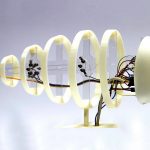 Over the years I’ve covered a few fascinating projects that aim to help clean up our oceans and waterways. For instance, the Row-Bot, from a team in Bristol, feeds on pollution in the water, with the nutrients used to power the robot onto its next ‘meal’.
Over the years I’ve covered a few fascinating projects that aim to help clean up our oceans and waterways. For instance, the Row-Bot, from a team in Bristol, feeds on pollution in the water, with the nutrients used to power the robot onto its next ‘meal’.
I also mentioned the floating barriers developed as part of the Ocean Cleanup project, which consists of a number of v-shaped floating barriers that are attached to the sea floor. As the current washes plastic through the barriers, they are caught up in the device, which then concentrates the plastic via a non-permeable screen that sits beneath the surface.
Or you have the microbots being used to remove lead from water. The microbots were tube-shaped constructions consisting of three layers. The outer layer absorbed the lead from the water using graphene oxide. The bots are controlled by the middle layer, where nickel creates a ferromagnetic force that directs the motion of the robots. The inner layer provides the propulsion for the bots via a platinum propulsion system that feeds off of the hydrogen in the water.
Swimming with the robotic fishes
Now, a consortium consisting of the Technical University of Madrid, the University of Florence and the Centre for Automation and Robotics (CAR CSIC-UPM – an organisation that sits between the Madrid university and the Spanish National Research Council) have produced a robotic fish designed to help the burgeoning aquaculture industry.
The robots are designed to monitor the pH level of the water to alert staff when it becomes either too acidic or poisonous. Such conditions usually result in changes in swimming patterns among the fish.
“Thanks to this system that provides early information on environmental change, we can control the parameters of water quality and improve management decisions of fish farms, and consequently, the wellness of these animals,” the team say.
The fish is roughly 30cm in length and is designed to mimic the movements of a fish. The hope is that the more natural movements will enable the fishes it shares its habitat with to engage more naturally with it.